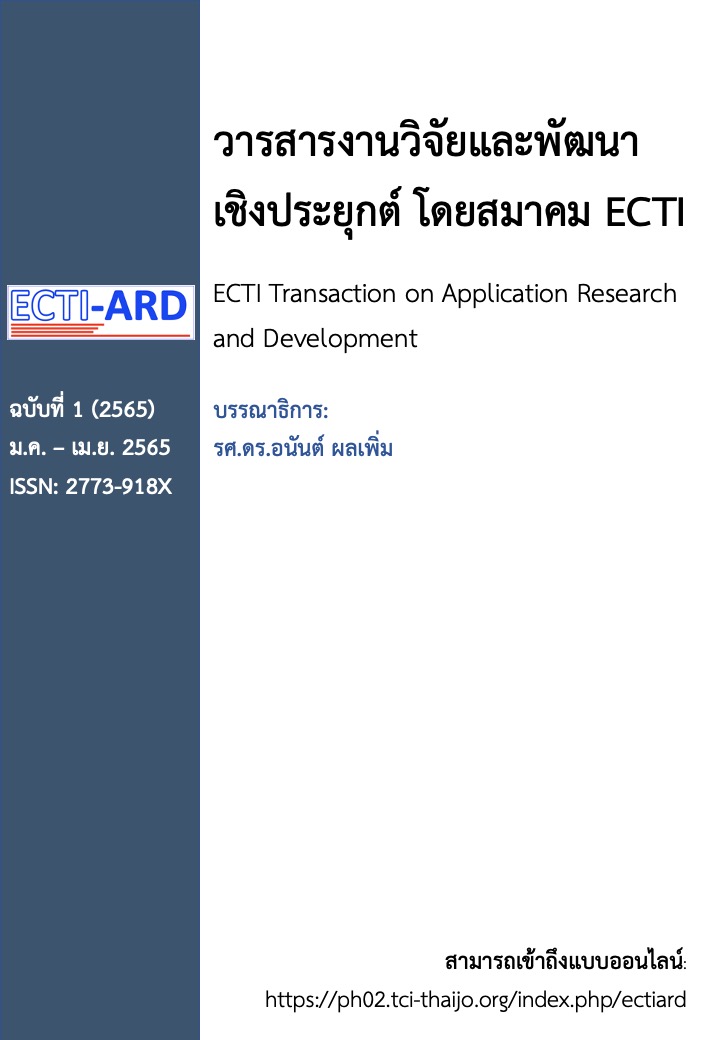Quality Evaluation of VoIP Codecs in Cellular Mobile Networks
Main Article Content
บทคัดย่อ
Maintaining the Quality-of-Service (QoS) of Voice-over-Internet Protocol (VoIP) is a major problem due to the instability of network conditions. One factor that influences VoIP call quality is the employed codec. In this research, the influence of codec on the QoS of VoIP calls is evaluated under Wi-Fi, 2G, 3G and 4G networks. VoIP calls are established using PCMA, PCMU, GSM and G.722 codecs and QoS parameters including jitter, round trip time and packet loss are measured. QoS measurements are compared against considered networks and codecs. Results illustrate that there exists a codec that better suits each network with considerable advantages over other codecs and minimum drawbacks.
Article Details

อนุญาตภายใต้เงื่อนไข Creative Commons Attribution-NonCommercial-NoDerivatives 4.0 International License.
เอกสารอ้างอิง
T. Wallingford, “Switching to VoIP”, O’Reilly Media, June 2005.
L. Audah, A.A.M Kamal, J. Abdullah and S.A. Hamzah, ”Performance evaluation of voice IP using multiple audio codec schemes ”, 10. 8912-8919 , January 2015.
S. Vadivelu, “Evaluating the Quality of Service in VoIP and comparing various encoding techniques”, MSc Thesis, Department of Computer Science University of Bedfordshire, UK, 2011.
L. Haibeh, N. Hakem, and S. Safia, “Performance evaluation of VoIP calls over MANET for different voice codecs”, 10.1109, 1-6, 2017.
N. Aftab, M. Hassan, M. N. Ashraf, and A. Patel, “Performance Evaluation of G.711 and GSM Codecs on VoIP Applications Using OSPF and RIP Routing Protocols”, 2nd International Conference on Wireless Intelligent and Distributed Environment for Communication, 2019.
S. Dhar and S. Chatterjee, “A study of VOIP codecs performance over IEEE 802.11n,” 2017 Devices for Integrated Circuit (DevIC), 2017, pp. 121-124.
S. Gurrapu, S. Mehta and S. Panbude, “Case Study for Performance Analysis of VoIP Codecs in Non-Mobility Scenarios”, International Journal of Computational Science and Information Technology (IJCSITY), Vol.5, No.1, 2017.
I. Aktas, F. Schmidt, E. Weingärtner, C. Schnelke and K. Wehrle. “An Adaptive Codec Switching Scheme for SIP-Based VoIP”, NEW2AN, 2012.
H. Singh and M Mian, “Comparative Study and Analysis of Various VoIP Coding Algorithms”. International Journal of Computer Applications 141(2):6-10, May 2016.
M. Miraz, S. Molvi, M. Ganie, M. Ali and A. Hussein. “ Simulation and Analysis of Quality of Service (QoS) Parameters of Voice over IP (VoIP) Traffic through Heterogeneous Networks”, International Journal of Advanced Computer Science and Applications, 8(7):242-248, 2017.
D. Wu, “Performance Studies of VoIP over Ethernet LANs”, MSc Thesis, Auckland University of Technology, 2008.
A high quality low complexity algorithm for packet loss concealment with G.711, ITU, Geneva, Switzerland. Rec. ITU-T G.711, App 1, 1999.
N. Shetty, and J. Gibson, “Packet Loss Concealment for G.722 using Side Information with Application to Voice over Wireless LANs”, Journal of Multimedia, 2(3), pp. 66-76, 2007.
Z. Wu, Chapter 7 - The GSM (RPE-LTP)-Based Speech Information Hiding Approach, Information Hiding in Speech Signals for Secure Communication, Syngress, ISBN 9780128013281, 2015.
J. Uerta, and R. Stern, “Distortion-Class Modeling for Robust Speech Recognition Under GSM RPE-LTP Coding”. Speech Communication, Vol. 34, pp. 213-225, 2001.
N. Ghiata and M. Marcu, “Measurement Methods for QoS in VoIP Review”, 3rd International Congress on Ultra Modern Telecommunications and Control Systems and Workshops, Budapest, Hungary, October 5-7, 2011.
S. Brunner and A. Ali, “Voice Over IP 101”, Juniper Networks, Inc., 2004.


